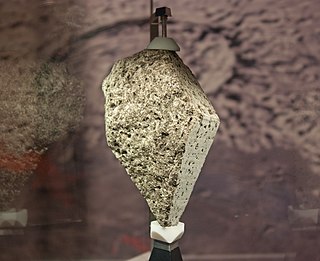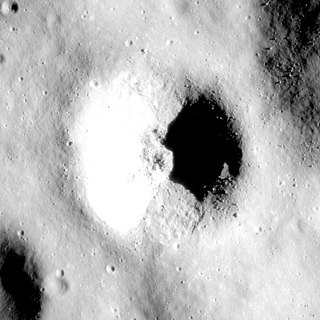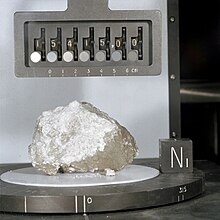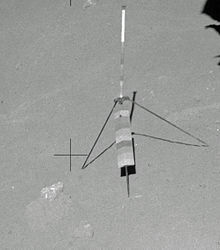
Apollo 14 was the eighth crewed mission in the United States Apollo program, the third to land on the Moon, and the first to land in the lunar highlands. It was the last of the "H missions", landings at specific sites of scientific interest on the Moon for two-day stays with two lunar extravehicular activities.

The Moon is Earth's only natural satellite. It orbits at an average distance of 384,400 km (238,900 mi), about 30 times the diameter of Earth. Over time Earth's gravity has caused tidal locking, causing the same side of the Moon to always face Earth. Because of this, the lunar day and the lunar month are the the same length, at 29.5 Earth days. The Moon's gravitational pull – and to a lesser extent, the Sun's – are the main drivers of Earth's tides.

In geology, the crust is the outermost solid shell of a rocky planet, dwarf planet, or natural satellite. It is usually distinguished from the underlying mantle by its chemical makeup; however, in the case of icy satellites, it may be distinguished based on its phase.

Mare Cognitum is a lunar mare located in a basin or large crater which sits in the second ring of Oceanus Procellarum. To the northwest of the mare is the Montes Riphaeus mountain range, part of the rim of the buried crater or basin containing the mare. Previously unnamed, the mare received its name in 1964 in reference to its selection as the target for the successful impact probe Ranger 7, the first American spacecraft to return closeup images of the Moon's surface.

The Fra Mauro formation is a formation on the near side of Earth's Moon that served as the landing site for the American Apollo 14 mission in 1971. It is named after the 80-kilometer-diameter crater Fra Mauro, located within it. The formation, as well as Fra Mauro crater, take their names from a 15th-century Italian monk and mapmaker of the same name. Apollo 13 was originally scheduled to land in the Fra Mauro highlands, but was unable due to an in-flight technical failure.

Anorthosite is a phaneritic, intrusive igneous rock characterized by its composition: mostly plagioclase feldspar (90–100%), with a minimal mafic component (0–10%). Pyroxene, ilmenite, magnetite, and olivine are the mafic minerals most commonly present.

Mons Hadley Delta (δ) is a massif in the northern portion of the Montes Apenninus, a range in the northern hemisphere of the Moon adjacent to Mare Imbrium. It has a height of 3.6 km above the plains to the north and west.

The geology of the Moon is quite different from that of Earth. The Moon lacks a true atmosphere, and the absence of free oxygen and water eliminates erosion due to weather. Instead, the surface is eroded much more slowly through the bombardment of the lunar surface by micrometeorites. It does not have any known form of plate tectonics, it has a lower gravity, and because of its small size, it cooled faster. In addition to impacts, the geomorphology of the lunar surface has been shaped by volcanism, which is now thought to have ended less than 50 million years ago. The Moon is a differentiated body, with a crust, mantle, and core.

Moon rock or lunar rock is rock originating from Earth's Moon. This includes lunar material collected during the course of human exploration of the Moon, and rock that has been ejected naturally from the Moon's surface and landed on Earth as meteorites.

A sample-return mission is a spacecraft mission to collect and return samples from an extraterrestrial location to Earth for analysis. Sample-return missions may bring back merely atoms and molecules or a deposit of complex compounds such as loose material and rocks. These samples may be obtained in a number of ways, such as soil and rock excavation or a collector array used for capturing particles of solar wind or cometary debris. Nonetheless, concerns have been raised that the return of such samples to planet Earth may endanger Earth itself.

The oldest dated rocks formed on Earth, as an aggregate of minerals that have not been subsequently broken down by erosion or melted, are more than 4 billion years old, formed during the Hadean Eon of Earth's geological history, and mark the start of the Archean Eon, which is defined to start with the formation of the oldest in-tact rocks on Earth. Meteorites that were formed in other planetary systems can pre-date Earth. Particles from the Murchison meteorite were dated in January 2020 to be 7 billion years old.

Lunar soil is the fine fraction of lunar regolith found on the surface of the Moon and contributes to the Moon's tenuous atmosphere. Lunar soil differs in its origin and properties significantly from terrestrial soil.

The Lunar Magma Ocean (LMO) is the layer of molten rock that is theorized to have been present on the surface of the Moon. The Lunar Magma Ocean was likely present on the Moon from the time of the Moon's formation to tens or hundreds of millions of years after that time. It is a thermodynamic consequence of the Moon's relatively rapid formation in the aftermath of a giant impact between the proto-Earth and another planetary body. As the Moon accreted from the debris from the giant impact, gravitational potential energy was converted to thermal energy. Due to the rapid accretion of the Moon, thermal energy was trapped since it did not have sufficient time to thermally radiate away energy through the lunar surface. The subsequent thermochemical evolution of the Lunar Magma Ocean explains the Moon's largely anorthositic crust, europium anomaly, and KREEP material.

Troctolite 76535 is a lunar sample discovered and collected on the Apollo 17 mission in 1972 in the Taurus–Littrow valley. It has a mass of about 156 grams (5.5 oz) and is about 5 centimeters (2.0 in) across at its widest point. It was collected by geologist astronaut Harrison Schmitt as part of a "rake sample" of lunar soil at Geology Station 6, near the base of the North Massif. Troctolite 76535 has been called the most interesting sample returned from the Moon.

Hadley–Apennine is a region on the near side of Earth's Moon that served as the landing site for the American Apollo 15 mission, the fourth crewed landing on the Moon and the first of the "J-missions", in July 1971. The site is located on the eastern edge of Mare Imbrium on a lava plain known as Palus Putredinis. Hadley–Apennine is bordered by the Montes Apenninus, a mountain range, and Hadley Rille, a meandering channel, on the east and west, respectively.

Lunar Sample 61016, better known as "Big Muley", is a lunar sample discovered and collected on the Apollo 16 mission in 1972 in the Descartes Highlands, on the rim of Plum crater, near Flag crater. It is the largest sample returned from the Moon as part of the Apollo program. The rock, an 11.7 kg (26 lb) breccia consisting mainly of shocked anorthosite attached to a fragment of troctolitic "melt rock", is named after Bill Muehlberger, the Apollo 16 field geology team leader.

North Ray crater is a small crater in the Descartes Highlands of the Moon visited by the astronauts of Apollo 16. The name of the crater was formally adopted by the IAU in 1973. It is the largest crater sampled by astronauts during the Apollo program.

Spur is a feature on Earth's Moon, a crater in the Hadley–Apennine region. Astronauts David Scott and James Irwin visited it in 1971, on the Apollo 15 mission, during EVA 2. Spur was designated Geology Station 7.

Lunar Sample 14321, better known as "Big Bertha", is a lunar sample containing an embedded Earth-origin meteorite collected on the 1971 Apollo 14 mission. It was found in the Fra Mauro region of the Moon. Big Bertha is the first discovered meteorite from Earth, and the embedded meteorite portion is the oldest known Earth rock. At 8.998 kg (19.84 lb), this breccia rock is the third largest Moon sample returned during the Apollo program, behind Big Muley and Great Scott.
ISOCHRON is a proposed lunar sample-return mission that would retrieve samples of the youngest lunar mare basalt.






















